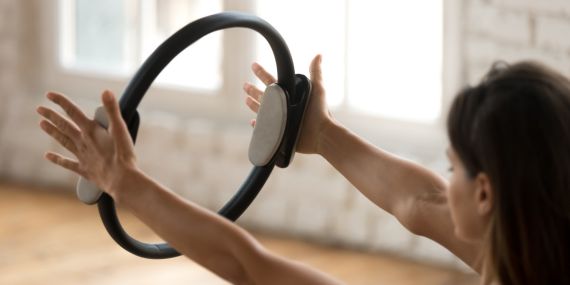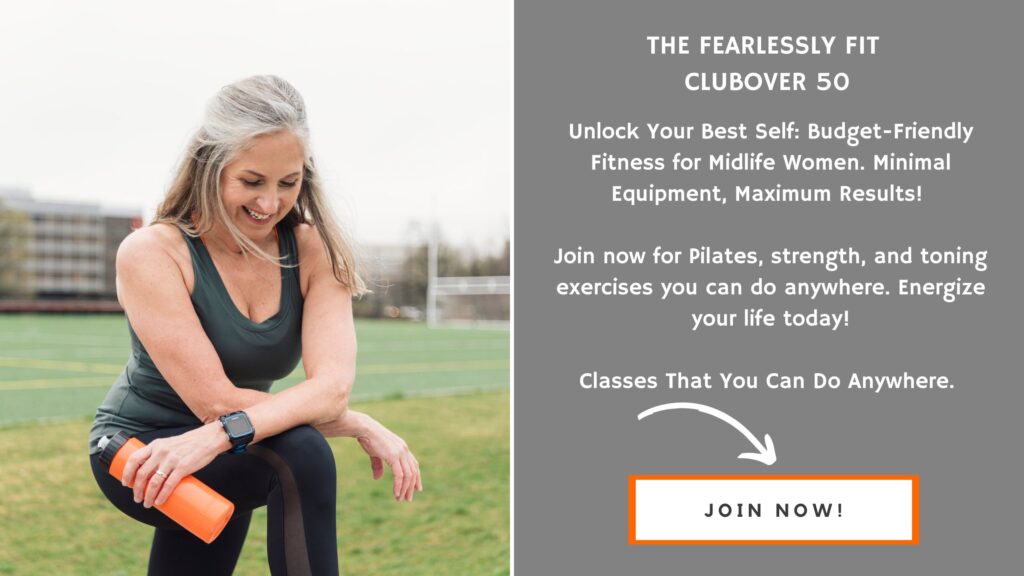As we get older, our joints can start to feel increasingly bothersome and achy. You try to stay fit by lifting weights, walking, or running, but you just feel even more joint pain than you did before doing those activities. It can start to seem like working out just isn’t worth it anymore. If you’re looking for something to keep you active that doesn’t leave you in more pain than you started, you may want to try doing Pilates at home!

Doing Pilates at Home
Pilates does wonders for the aging body and is easy on the joints. If you ideally want to exercise at home with little to no equipment, pilates can be done without using machines or contraptions you may be intimidated by. But how would you get started on this venture into a new type of activity you didn’t even know existed until recently?
My Spark Fitness Membership walks you through everything you need to know to start doing Pilates yourself at home. I include workouts all the way from the beginner level to the advanced so you can learn and get stronger with the program gradually.
First, I want to talk about the origins and benefits of Pilates so you can understand the bigger picture here.
What is Pilates?
Pilates is named after the inventor Joseph H. Pilates. Pilates is a system of exercises designed to improve physical strength, flexibility, posture, breathing, and overall well-being for the entire body.
You can practice Pilates with specialized equipment, or in a more simplistic form with a Yoga or a Pilates mat. Pilates mats are thicker and are designed to not slip when you sweat, I recommend this one to start! There are over 500 exercises in the Pilates equipment repertoire, and 34 mat exercises.
Whether using specialized equipment or not, Pilates has amazing benefits, particularly for women over 50.
IS IT TOO LATE TO START PILATES OVER 50? – FIND OUT IN MY BLOG
What are the health benefits of Pilates for the over 50s?
Both men and women can benefit from taking up Pilates regularly. Some of the benefits include:
- Increasing your flexibility – by gently stretching your muscles, you increase flexibility in your joints, tendons, and ligaments; you move more easily and without pain
- Efficient movement in daily living
- Increased bone strength and support in your spine
- Helps to strengthen your core muscles which are essential for stability, strength, and balance
- Pilates is a great body-mind routine – as it focuses on your breathing; it’s gentle yet challenging at the same time
- Develops lean and long muscles without any bulk
- Pilates improves your posture
Research has shown that 3 Pilates sessions per week for 8 weeks can improve muscle strength in the lower body, in addition to postural stability. Muscle weakness and postural issues can not only exacerbate symptoms of arthritis but also contribute to the development of the condition

The 6 Pilates Principles
There are 6 Pilates principles that you’ll find in any Pilates class and that will become part of your practice as well.
- Centering: This is the practice of bringing your awareness to the center of your body—the area between the lower ribs and pubic bone.
- Concentration: By focusing on each exercise with your full attention, you’re connecting the mind and body while doing the exercises. You can think of it as mindful movement.
- Control: There is no bouncing or impact in the Pilates matwork. Every Pilates exercise requires deliberate execution and focus.
- Precision: Staying aware and connected while moving through each exercise with control and proper alignment and engagement of the core.
- Breath: Joseph Pilates emphasized breathing into your lungs, inhaling and exhaling fully. Pilates exercises coordinate the breath with the movement. This is ideal for people who are shallow breathers.
- Flow: Pilates exercises are not meant to be rigid but fluid, graceful, and performed with ease. The idea is that the “powerhouse” connects the entire body into a single fluid motion.
It can feel like a moving meditation when all the principles come together as one. In a Pilates class, you’ll find that the variety of exercises during the class incorporate these principles in different combinations.
How to Get Started With Pilates at Home
Pilates has a reputation of being low-impact yet powerful. You can start Pilates at home without fancy equipment and get all the benefits.
Find a dedicated well-ventilated area so that you have room to move. There’s no need to start out with smaller Pilates equipment like the balls, rings, and bands just yet. You can add these pieces of equipment later on too! You can find all my best recommendations for at-home Pilates equipment here.
Wear comfortable clothing that doesn’t slide around your body. Pick something tight-fitting, but comfortable.
I always advise that you check with your doctor before beginning a new exercise program to make sure that is right for you.
I am including links below to a short video sequence that you can practice at home. These start with engaging the powerhouse and firing up your glutes, followed by 8 essential exercises for beginners with modifications.

Here’s a Few Frequently Asked Questions I Often Get About Pilates:
How often should I do Pilates as a beginner?
3 times per week is ideal to start.
My joints hurt. Is Pilates the right thing for me?
Yes, Pilates is low impact in nature and every exercise can be modified. There are countless ways to modify and adapt Pilates exercises, depending on your age, weight, physical ability, and level of fitness. The exercises are designed with modifications so that people of all levels and abilities can stay safe while being physically challenged.
When can I expect to see results?
The results depend on the goals you set for yourself. Better posture, a stronger core, or overall well-being all differ from person to person.
It’ll take a while until you master every exercise, so take your time and enjoy the fun, low impact and so very beneficial Pilates mat exercises that any woman over 50 can do.
Check out my Spark Fitness membership for other Pilates mat, Pilates on the ball, and Pilates fusion workouts. The first 3 workouts are free so that you can get started right away!
Share this post with your friends so that they can find out how awesome Pilates for women over 50 is to help you to get lean and stronger.

Pingback: 3 Irresistible Reasons To Start Pilates Over 50 And Make It A Habit
Pingback: 10 Age-Defying Health Tips for Postmenopausal Women
Comments are closed.